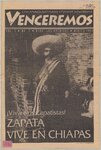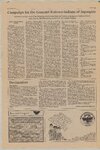| OCR Text |
Show WINTER VENCEREMOS 1994 Chiapas which seized what is now the from page four Texas, most of present day Colorado and parts of Kansas and Oklahoma (collectively named Aztlán by Chicanas/os], in the Imperialist War (known in the U.S. as the Mexican- Mexican Government Immediately following the outbreak of violence on January 1st, EZLN leaders faxed a communiqué to various news oOrga- nizations throughout Mexico. VENCEREMOS has obtained a copy of this and other communiqués issued by the EZLN since the intifada's beginning, and we have reproduced this first “Declaration from the Lancadon Jungle” below. The Communiqué formally declares war on the Mexican government, and outlines the main grievances which precipitated the January 1st uprising. The communiqué asserts that Revolution is the legal right of the Mexican People, citing arti- In Santa Marta, two townspeople were imprisoned and All this should not have been. The 1910 Revolution which overthrew the dictator Porfirio in 1528, which led to the estab- convicted of “promoting false Díaz grew from national discon- lishment of the first Spanish miracles” Pedro Chelanó. Tenochtitlán. Chiapas was finally conquered for the Spanish by Diego de Mazariegos states of Utah, California, Nevada, Arizona, New Mexico, city in Chiapas, Ciudad Real (now San Cristóbal de Las Casas). Immediately following the conquest, large-scale Indian rebellions broke out in 1532 and y : 1534, It was during the second American war) of 1846-1848. The war ended with the signing of The Treaty of Guadalupe Hidalgo which formally ceded Mexico's Nortwest (now called nal price of $15 million. The communiqué calls for a nationwide fight against colonialist oppression perpetrated by the Mexican government. It calls upon “other powers of the nation to advocate to restore the legitimacy and the stability of the nation by overthrowing the dictator.” rebellion, Chiapanec after constructing a tent surrounding Mexico's cruel shrine to an apparation of the Virgin Mary in the surrounding forest. They were sentenced to 200 lashes of the whip and 10 .neo-colonial caste system. The years of exile from the province. Followers of a similar cult in the town of San Pedro Chelanó rebellion that the famous “Legend of El Sumidero” was born. The legend recounts how towards the end of the 1534 “the Southwest”) for the nomi- Indians without inci- de dent to disbe- Chiapa flows through Sumidero Canyon. Pursued and outnum- lieve the alleged mountains where El Río miracles some said had occurred there on at least two separate occasions. bered, many of the remaining Indians flung themselves to their deaths from the cliff tops Later that year when the Virgin Mary was sighted in the trouble began. The thirteen year old daughter of Agustín López (sacristan of Cancuc) confessed she had seen the Virgin Mary on the outskirts of town. A new cult soon flourished. López organized a new religious hierarchy to administer the cult and assist in organizing a rebellion to protesting church suppression of the cult. o “Rebel”. priests Were ordained, and during the first week of August, a call to war was issued renouncing obedience to both “God and King.” Chiapas” entire eastern plateau was soon in open rebellion. Representatives of twenty-one pueblos gathered at Cancuc, and in the fighting which followed, five Dominican curates and the entire mestizo populations of -Chilón and Ocosingo were mas- sacred. Photo courtesy Lilliana Nieto Del Rio for The New York Times The colonial militia was inef- Refugees gathering last week in¡ Chiapas in southern Mexico. The Government received its first formal contact from the rebel leadership there. fective in quelling the rebellion. Imperial troops from Guatemala were finally called in, and upon rather than submit to their Spanish conquerors. This mass suicide reduced the numbers of the Chiapanec people from Ten's of thousand to a mere 2,000. While the hito truth of the legend is disputable, what is indisputable is the legend's affect on the indígenas. The leg- arrival, they met 5-6 thousand indígenas acting as an organized army. Their army is known to history as “The soldiers of the Virgin.” Chiapas was pacified by The “dictator” is of course cle 39 of Mexico's Constitution reads: “National sovereignty essentially and orig- inally resides in the people and its purpose is to help the people. The people have, at all times, the inalienable right to alter or modify their form of government.” none other than Mexico's current President and PRI (Institutional Revolutionary Party) chief, Carlos Salinas de Gortari. Salinas is only the lat- “est dictator.. Fhe PRiSparty has ruled Mexico since the smoke cleared on the 1910 Mexican Revolution, which The communiqué addresses overthrew the “cientifico” dicthe legality of the struggle withtator Porfirio Díaz. Díaz in the context of international oppressed the rules of engageMexican people ment. It reads: “They saw them as just. as. .Phé “We declare nothing more than Salinas governnow and always ment 1s anthropological that we are subof Ject to the touristic accused objects, Geneva E TE Accord CONT" muniqué's sec- ond directive assures that the EZLN's opera- tives will espect tie lives of its pris- curiosities, or part of a “Jurassic Park" which fortunately would disappear with a Free ” Agreement. oners and turn over all wounded to the International Red Cross.” The fifth directive reads: “We ask for the unconditional surrender of the enemy's headquarters before we begin any combat to avoid any loss of life.” The communiqué points to U.S: imperialistas tle Mexican government's silent partner in the immediate and historical oppression of Mexico's indigenous peoples. The current Mexican govern- ment is characterized as “the same ones who sold half of our country to the foreign invader ..." The “foreign invader” refers to the United States of America, Trade oOppressing them today. The commu- niqué closes by calling upon all who read it to “JOIN THE FORCES OF INSURGENT THE Z.APATISTA ARMY OF NATIONAL LIBERATION.” 2 February of 1713. The revolt changed the political climate in Chiapas forever: The indígenas proved their capabllity act with end represents the beginning of a broad ethnic consciousness a proud tradition of defiance in the face of colonial oppression. Chiapas' indígenas rebelled which recognized their collective indigenismo over other loyalties. again in 1712 in response to colonial suppression of the indígenas' religious practices. Charges of “religious cults” (religion * that” :blended Catholicism and indigenous beliefs) among converts were common in Chiapas through- Prelude to-Rebellion. “We have no middle class; there are the rich, who are very rich, and the poor, who are extremely poor.” So remarked the former governor of Chiapas miracles were reported in the towns of Santa Marta, and San oppression of campesinos (peasants) and the system of peonage that perpetuated extreme poverty in the in 1937. The ejido system intended to transfer substantial portions of Mexico's arable land out of the hands of wealthy land owners and into the hands of the campesinos. The new sys- tem designated lands surrounding the pueblos (villages) as communal property belonging to that village's people. Large estates were nationalized, ship. In Chiapas, the ejido system met with only limited success, and what success it had was quickly undone. During the 1970s and 80s, many of the Indígenas” ejido lands were found to be rich in valuable natural resources. This rediscovery of Chiapas intensified the usually violent oppression of the Indígenas who were struggling to protect their ejidal lands against encroachment from wealthy hacendados (plantation owners) and ganaderos (cattle ranchers). The became Indígenas” protests more vocal in response to the more militant tactics of the white haciendados and ganaderos. The protests became highly organized, and began to represent a threat to the profits of wealthy land owners. A widening cycle of protest, violent repression, followed by more vocal protest, etc., soon characterized Chiapas” political climate. are These two decades notable for the widespread use of both non-violent and violent tactics by the indígenas” protest movements. A good example of a non-violent protest is the mass demonstration in the municipo of Simjovel in May of former governor taken prisoner by the EZLN at the uprising's beginning). marched, demanding immediate agrarian reform for the see “Chiapas” on page eight 1980. Over 15,000 Indígenas In Chiapas, you are either an * indirena sora ladinmo (Guatemalan term for “White” or “Non-Indian”). The EZLN's New Year's Day revolution is a response to a system of inequities which have existed in Chiapas since colonial times. It is only one of many rebellions that have occurred since the Spanish conquest. Chiapas' forbidding topogra- ) the fall of the Aztec capital, Photo courtesy Lilliana Nicto The Eno bro- ken up, and appropriated to the pueblos, thus intending to end most large-scale private owner- A Struggle Against History phy allowed the region to remain unconquered well after pre- revolutionary economy. The positive effects of the Revolution's reforms felt in other parts of Mexico have never reached Chiapas. Chiapas' economic structure remained largely unchanged even after the country's move to the ejido system General Absalón Castellanos Domínguez, in an interview with Excelsior (Mexico City) out the 16th century, but the events of 1712 sparked a major “ following his 1982 gubernatorial appointment (he is the same rebellion In the spring of 1712, alleged revolution intended to bring a mA agrarian reform. the to send A peasant leader was hooded, beaten, and tortured by having a mixture of mineral water and chili peppers poured into his nostrils. were persuaded who refused to surrender to the Spanish retreated into the town of Cancuc, which - 5 of war: refugees displaced by the fighting. De Ñ |














